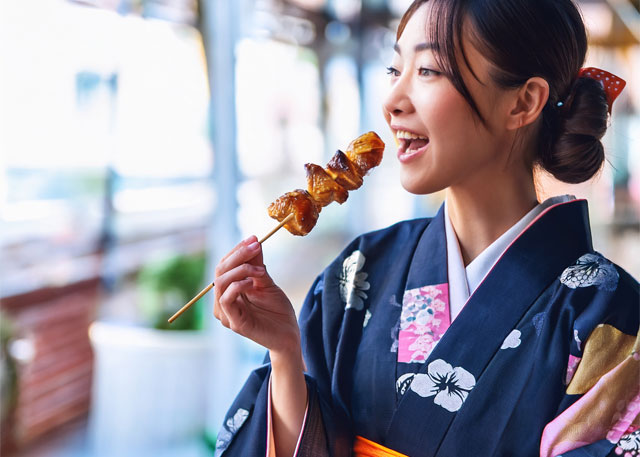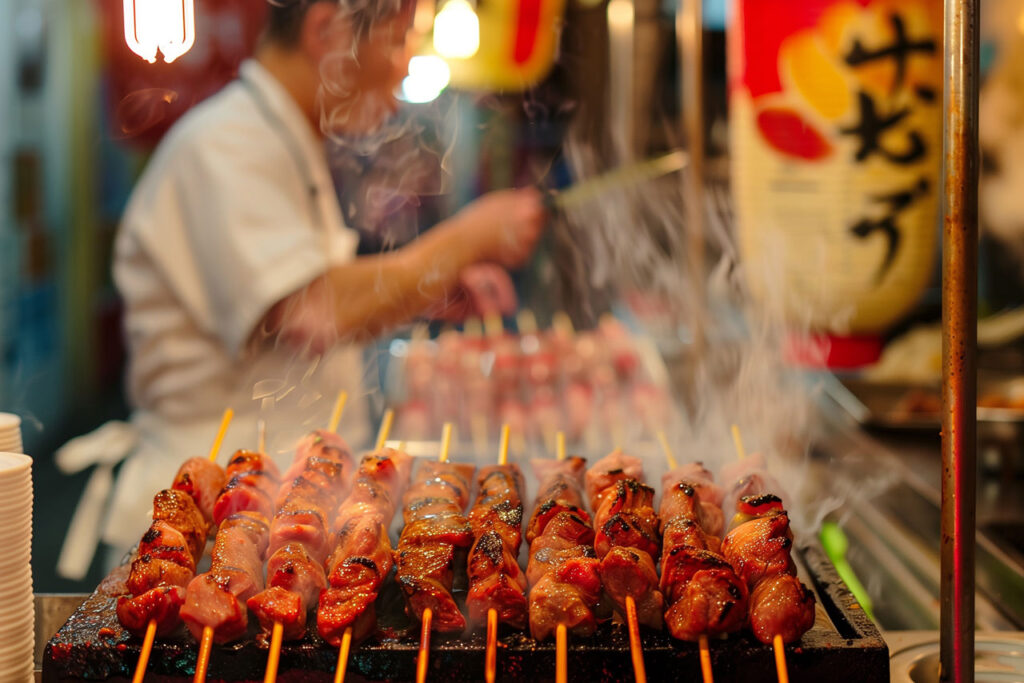Yakitori is often seen as a simple and familiar street food or izakaya staple in Japan.
But beneath its humble appearance lies a rich history, refined techniques, and growing global popularity that even many Japanese people may not fully realize.
This article dives into the lesser-known aspects of yakitori and explores how it connects with global grilling traditions.

1. The Origins and Evolution of Yakitori
Yakitori, or grilled chicken skewers, has its origins in the Edo period (around 1689), where the name first appeared in historical documents.
However, the style we know today—chicken pieces skewered and grilled over charcoal—didn’t become widespread until the Meiji era, nearly 200 years later.
At the time, chicken was a luxury item, and yakitori was not yet an everyday food.
People used not only meat but also organ meats to avoid waste. As charcoal grilling techniques spread among the public, yakitori gradually evolved into a skilled craft.
Today, skilled chefs offer a variety of cuts, each grilled and seasoned to bring out its unique flavor.
While most people enjoy popular cuts like thigh (momo) or breast (mune), yakitori also includes more unique parts:
- Sunagimo (gizzards): Chewy and flavorful.
- Reba (liver): Rich in nutrients with a distinctive texture.
- Hatsu (heart): Firm and satisfying to chew.
- Nankotsu (cartilage): Crunchy and often enjoyed for its texture.
These lesser-known parts not only add variety but also offer rich nutrition when prepared with care.
2. The Art of Grilling and Seasoning
Yakitori is more than just grilled chicken. Charcoal grilling brings out a unique aroma and flavor, and seasoning is a delicate art.
Many shops use “secret sauces” (tare), each with its own balance of sweetness, saltiness, and umami.
These sauces are often aged and added to over the years, creating deep complexity.
Even the way skewers are arranged affects how heat is distributed and how the flavors are sealed in.
From seasoning to grilling to plating, every step reflects craftsmanship.

3. Surprisingly Healthy?
Yakitori isn’t just a tasty snack—it’s also gaining recognition as a balanced and health-conscious meal.
Lean meats like chicken breast and gizzards are low in fat and high in protein. Liver is rich in iron, and salt-seasoned yakitori offers a low-carb option for those watching their sugar intake.
This balance of taste and nutrition makes yakitori ideal for people looking for flavorful yet healthy food.
4. Behind the Scenes: The Yakitori Industry
Behind every skewer is a story of hard work—from sourcing ingredients to ensuring hygiene and maintaining quality.
One seasoned chef explained, “The secret to great yakitori is respecting the ingredient and mastering the heat.”
These behind-the-scenes efforts remind us that yakitori isn’t fast food—it’s a deeply rooted craft and part of Japanese culinary culture.
5. Global Cousins of Yakitori
Yakitori-style skewered meats can be found around the world:
- Korea – “Dak-kkochi”(닭꼬치): Chicken skewers grilled and coated in sweet-spicy sauces, often sold at street stalls.
- Indonesia/Malaysia – Satay: Skewers of meat marinated in spices and served with peanut sauce.
- Middle East – Shish Kebab: Marinated meats (chicken, lamb, beef) grilled on skewers, often juicy and aromatic.
- Brazil – Espetinho: Salted skewers grilled over charcoal, similar in spirit to Japanese “shio-yaki” (salted yakitori).
These global variations highlight a shared love for skewered and fire-grilled foods.
6. Yakitori Goes Global
Yakitori has gained popularity overseas, especially in cities like New York and Paris. High-end yakitori dining has emerged, with chefs replicating Japanese techniques.
Some even earned Michelin stars, such as Torien and Yakitori Totto in New York.
Abroad, yakitori is often branded as Japanese BBQ, and its simple, shareable nature appeals to health-conscious and foodie audiences alike.
Innovations like vegetarian yakitori and halal-friendly options also help yakitori reach more global diners.
7. Yakitori Around the World: Key Trends
USA (NYC, LA):
Authentic yakitori bars are popular among foodies. Emphasis is placed on traditional methods—charcoal, tare sauce, and skewer precision.
Europe (London, Paris):
Izakaya-style restaurants offer yakitori with sake or wine pairings. Vegetarian skewers (zucchini, mushrooms) are also trending.
Asia (Thailand, Singapore, Taiwan): Japanese franchises and local-style yakitori pubs are expanding, often adapting flavors to local tastes.
8. Why Is Yakitori So Universally Loved?
- ✅ High protein, low-fat, and often gluten-free
- ✅ Flavorful thanks to charcoal and simple seasoning
- ✅ Easy to share and perfect for social dining
- ✅ Works from street food to fine dining
9. Rediscovering Japanese Food Culture Through Yakitori
For many Japanese people, yakitori is everyday fare. But the techniques, traditions, and global influence behind it tell a much deeper story.
What was once humble street food has become an international ambassador of Japanese flavor and craftsmanship.
So next time you enjoy a skewer of yakitori, take a moment to appreciate the skill, history, and cultural richness behind that delicious bite.

Below is a sample list of recommended yakitori (and related skewer) establishments in the Greater Tokyo area that are popular with international visitors.
Please note that details (addresses, websites, etc.) may change over time, so it’s advisable to verify the information before planning your visit.
- Yakitori Ichidori
- Address: B1F, Tokyo Station Ichibangai 1-9-1 Marunouchi, Chiyoda-ku, Tokyo, Japan
- Website: Tabelog Website
- Description: You can find Yakitori Ichidori in the B1 North area of Tokyo Station’s First Street, which is a dining area.164 meters from Tokyo.
- Gonpachi Asakusa Azumabashi
- Address: 1F・2F Nakagawa Bld. 2-1-15 Kaminarimon Taitoku Tokyo
- Website: Gonpachi Official Site
- Description: This branch of the famous Gonpachi chain offers a lively, traditional atmosphere in the historic area of Asakusa. Its accessible location and menu (with some English guidance) make it popular among foreign tourists.
- Kushiyaki Bistro Fukumimi Ginza 5 Ten
- Address: B1F, Ginza YK Building 5-10-9 Ginza, Chuo-ku, Tokyo, Japan
- Website: Tabelog Website
- Description: 3 minutes walk from Exit A3 of Ginza Station on the Ginza Subway Line.165 meters from Higashi Ginza.
- Torigin Ginza Honten
- Address: B1F, Ginza YK Building 5-10-9 Ginza, Chuo-ku, Tokyo, Japan
- Website: Torigin Official Webite
- Description: Renowned for its authentic yakitori preparations, Torigin offers an elegant setting in Tokyo’s upscale Ginza district, with an English website and menu details available upon inquiry.
- Kuriya
- Address: 1-15-8 Maruo Bldg. B1F, Kabukicho, Shinjuku 160-0021 Tokyo, Japan
- Website: food 96
- Description: Kuriya is known for its unique selection of yakitori and seasonal dishes. The restaurant’s refined ambience and attentive service make it a favorite among international travelers seeking an authentic yet polished dining experience.
We encourage you to explore these establishments and enjoy the vibrant culinary heritage of Japan’s skewered delights.
















